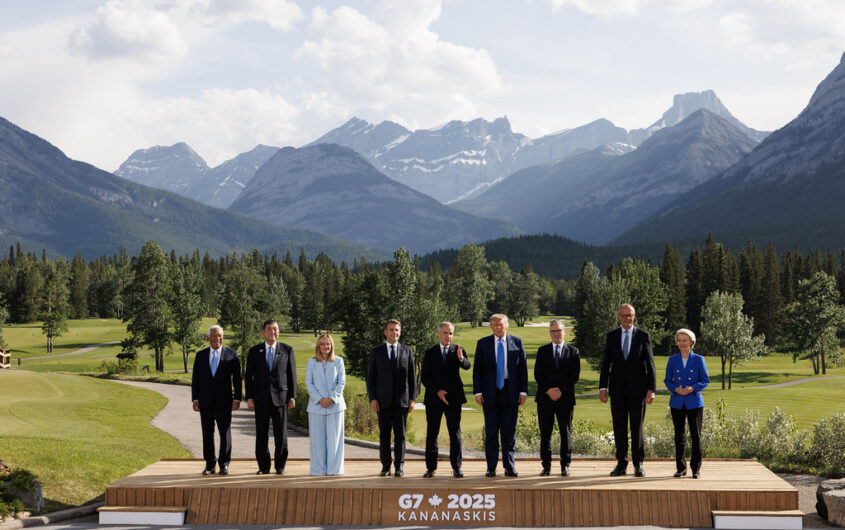
Simon Dawson / No 10 Downing Street via Flickr
The G7 Summit, Plus or Minus

Peter S. Rashish
Vice President; Director, Geoeconomics Program
Peter S. Rashish, who counts over 30 years of experience counseling corporations, think tanks, foundations, and international organizations on transatlantic trade and economic strategy, is Vice President and Director of the Geoeconomics Program at AICGS. He also writes The Wider Atlantic blog.
Mr. Rashish has served as Vice President for Europe and Eurasia at the U.S. Chamber of Commerce, where he spearheaded the Chamber’s advocacy ahead of the launch of the Transatlantic Trade and Investment Partnership. Previously, Mr. Rashish was a Senior Advisor for Europe at McLarty Associates, Executive Vice President of the European Institute, and a staff member and consultant at the International Energy Agency, the World Bank, UN Trade and Development, the Atlantic Council, the Bertelsmann Foundation, and the German Marshall Fund.
Mr. Rashish has testified before the House Financial Services Subcommittee on International Monetary Policy and Trade and the House Foreign Affairs Subcommittee on Europe and Eurasia and has advised three U.S. presidential campaigns. He has been a featured speaker at the Munich Security Conference, the Aspen Ideas Festival, and the European Forum Alpbach and is a member of the Board of Directors of the Jean Monnet Institute in Paris and a Senior Advisor to the European Policy Centre in Brussels. His commentaries have been published in The New York Times, the Financial Times, The Wall Street Journal, Foreign Policy, and The National Interest, and he has appeared on PBS, CNBC, CNN, NPR, and the BBC.
He earned a BA from Harvard College and an MPhil in international relations from Oxford University. He speaks French, German, Italian, and Spanish.
While the G7 economies today account for only 30 percent of global GDP, they remain a decent proxy for what can still be called the “West” in geopolitical terms. Or perhaps it is more accurate to say that the G7 and their annual summits are the best test of whether such a core group of like-minded countries—two from North America, four from Europe, and one from Asia—still exists.
By that yardstick, the June 16-17 gathering that took place in Kananaskis, Canada, was a modest success. It is true that President Trump chose to leave the meeting a day early to deal with the hostilities between Israel and Iran. And there was notably no single communiqué—the usual format for expressing a shared outlook on a range of policy challenges.
But there was a “Chair’s Summary” from Canadian Prime Minister Mark Carney as well as five “G7 Leaders’ Statements” (including one on Israel and Iran) and two other joint declarations reflecting areas where the seven countries took a common position on key global issues. Unsurprisingly, trade policy did not figure prominently in what the G7 revealed about their discussions given the U.S. administration’s posture on the issue, which is a combination of tariff-driven mercantilism on its purely commercial aspects and some openness toward cooperation on economic security challenges from China.
This second element of trade policy, however, did receive attention in Kananaskis, where the seven economies agreed “to safeguard their economies from unfair non-market policies and practices that distort markets and drive overcapacity in ways that are harmful to workers and businesses. This includes de-risking through diversification and reduction of critical dependencies.” Although this is an admittedly declaratory statement, the leaders took the more concrete step of creating a G7 Critical Minerals Action Plan with a commitment to “anticipating critical minerals shortages, coordinating responses to deliberate market disruption, and diversifying and onshoring, where possible, mining, processing, manufacturing, and recycling.”
The Kananaskis G7 summit demonstrates that at least some of the time, and on some issues, it should be possible to create coalitions of the willing even among a set of increasingly diverse economies.
Beyond critical minerals, the other overlapping economy-technology issue that received considerable attention was artificial intelligence. Here the G7 devoted most of its efforts to AI adoption and related efficiency gains and energy sector impacts, as well as the role of small- and medium-sized enterprises rather than how to ensure that AI does not exacerbate societal cleavages, although there was a commitment to “fully leverage the potential of AI to enable decent work while addressing challenges for our labour markets.”
Overall, there were a few items on the minus side of the G7 ledger: President Trump’s early departure, little discussion of the need to reform an aging global trading system, no common statement on Ukraine. But there were also pluses. One of those was who was present. While on the second day there was a kind of “G6” with the United States represented by Treasury Secretary Scott Bessent in the president’s absence, it is also true that with the Canadian government’s invited guests—the leaders of Australia, Brazil, India, Mexico, South Korea, South Africa, and Ukraine—there was a de facto G14 on the first day of deliberations. In addition, Australia, India, and Korea signed off on the critical minerals plan.
In an increasingly disorderly world, there will need to be more of this ad hoc coalition building among broadly like-minded economies. The Kananaskis G7 summit demonstrates that at least some of the time, and on some issues, it should be possible to do so even among a set of countries that has become more diverse in terms of domestic politics, foreign policy priorities, and geoeconomic interests.








